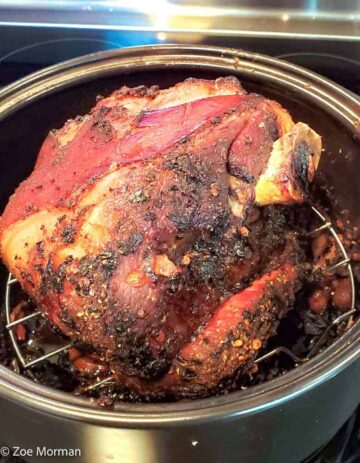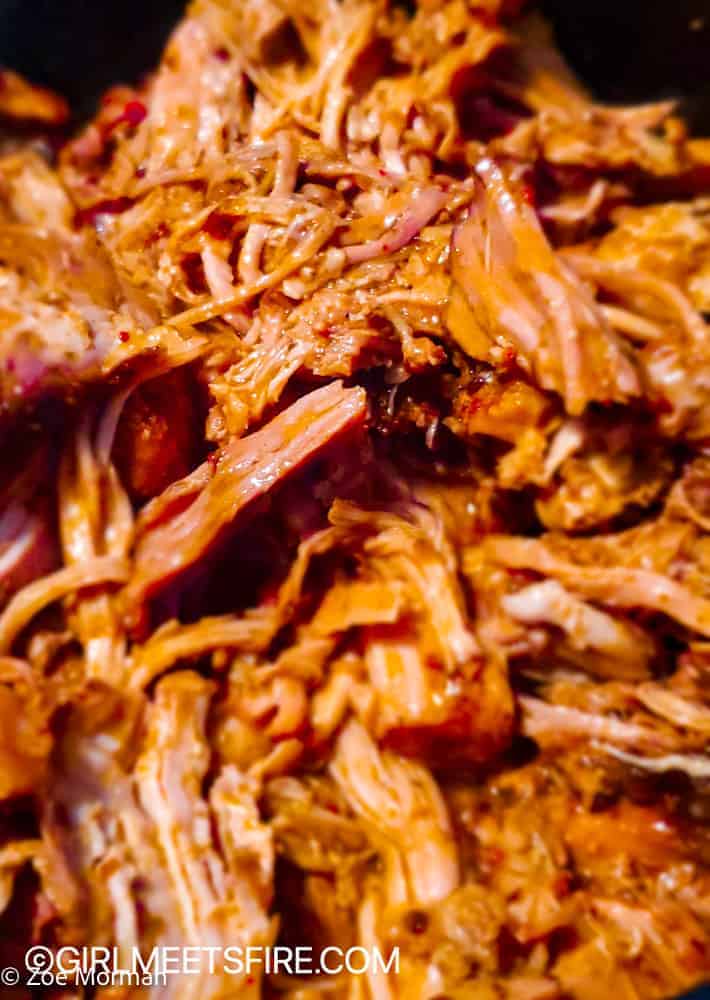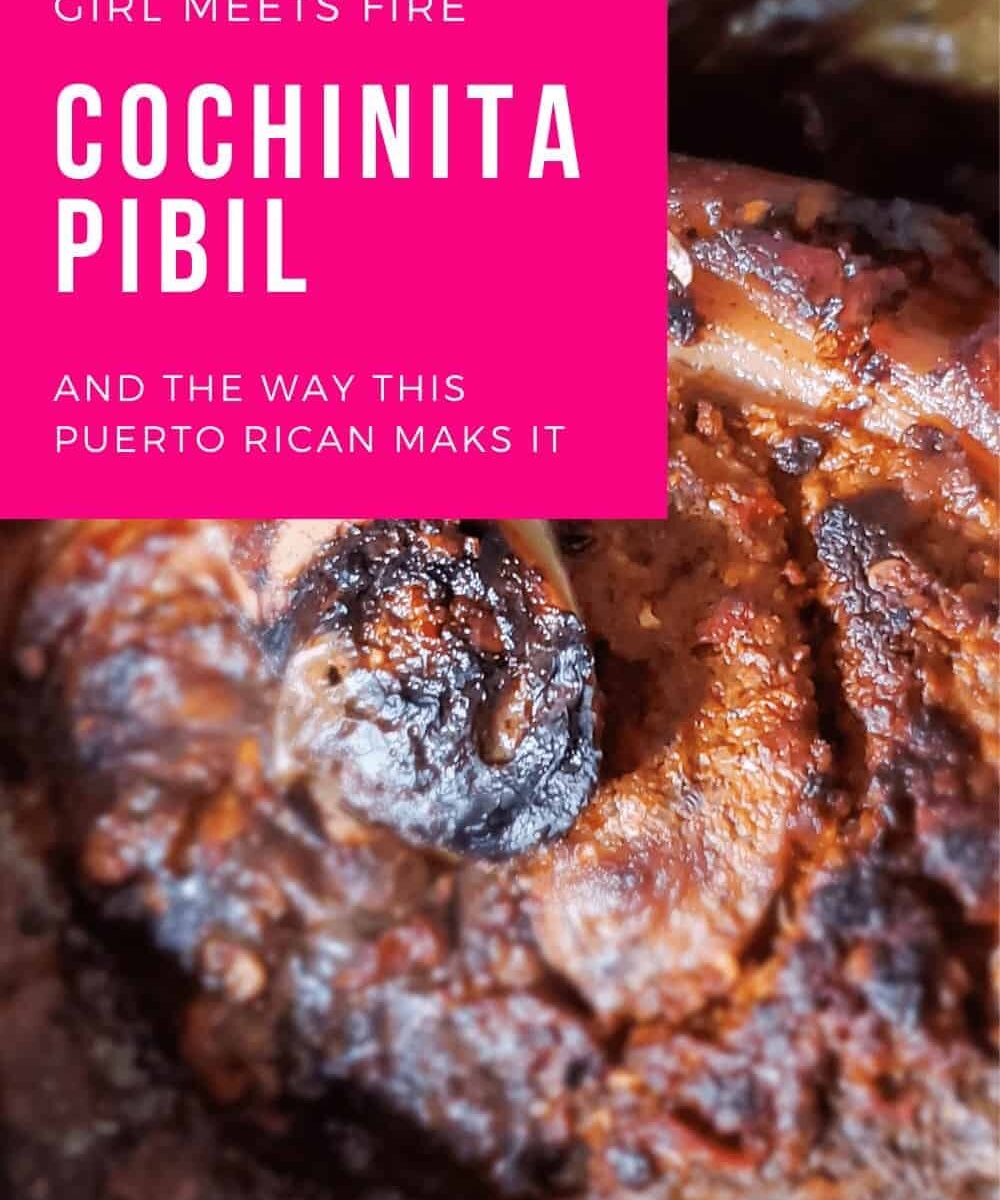What can I say about Cochinita Pibil? Other than I cannot wait to try the real thing!!! I watched The Chef's Table: BBQ on Netflix and fell in love with all the chefs and in particular with Rosalia Chay Chu. Rosalia is a Mayan Chef still utilizing Mayan culinary techniques millennia old. This very humble chef (which if you know a chef you know humility is a rare characteristic), walks the audience through how she makes her Cochinita Pibil. I immediately fell in love. If you like BBQ and tacos, this 4 part series is a MUST!
Because learning is a kindling, today we will learn:
What is this Cochinita Pibil you talk about so much?
I am OBSESSED with this dish even though I have not tasted the original Cochinita Pibil. My only reference has been what I have learned of this dish from watching Netflix. But using my culinary know-how 😉😉, I have recreated what I learned from the show to the best of my ability. By Rosalia's standards, Cochinita Pibil is pork (cochinita, which also refers to a suckling) that has been cooked in an underground oven (Pibil). The pork featured in the Netflix video is from the Yucatan region. It is leaner and seemingly smaller than our traditional porcine livestock.
How is Cochinita cooked in the Yucatan region?
The pig or Cochinita is chopped up and seasoned with spices and placed in a pot and covered with Banana or Plantain leaves. The pot is buried in a pit or Pibil, an underground oven, where wood chunks, coals, and rocks have been sweltering. Then the pot is covered with more branches, and the pit is filled with dirt and covered with even more branches and leaves. The next day, the pot is unearthed from the pibil to reveal succulent, juicy, tender pork meat that will be the filling to the taco.
But Zoe, if you never ate this, how do you know it's good?

Culinary know-how!!! Rosalia never gives out a true recipe. We watch her create this masterpiece as she guides us through the region and her ingredients. She uses a few ingredients that I know very well from past experiences. So, based on what I saw and what I know of Puerto Rican cooking, I tried to recreate her actions within my capacity.

This is a great example that as long as you know the fundamentals of a particular cuisine, or cooking in general, the culinary world is your oyster. Because you will know how to adapt your recipes with your means and needs. My friends, you are in luck. If you want to make my version of Cochinita Pibil, you will NOT need to dig a hole to recreate it.
A few pointers before we begin
The Pork
The Yucatan pig is a smaller, leaner variety than the pigs we consume here in the United States. The animals in this region have leaner diets and are not overfed for mass production as American pork is. Many people will consider them suckling pigs, but I do not think that is the case, for the pigs look slightly different. I believe that it was in another documentary where a panelist revealed the species. So, since we do not have access to this specific breed of pig, we will make a substitution.

I used a picnic roast. Any large shoulder cut would do the trick as well as a leg. I like a piece that still has a good size skin and fat cap. This will render the fat while cooking maintaining the meat tender and juicy. You can add other cuts of meat to the pot, but for me a four pound picnic roast was good to feed four (four tacos each person) and have left overs.

Tortillas
If you know someone who knows how to make really good tortillas, buy some tortillas from her (or him) and support their craft. Anyone that can make any specialty food has a skill that should be supported and making tortillas is not as easy as it looks. It takes a lot of practice and patience. But alas, I do not know anyone who knows how to tortillas, so I have to go to my supermarket and buy mine already made. My favorite store-bought tortillas are from La Tortilla Factory. These tortillas are bigger than a street taco tortilla and thicker. To me, they remind me of tamale dough. Super flavorful and fresh tasting. I highly recommend them.

Banana Leaves
The banana leaves give the pork an earthy bouquet. It also adds a smokiness to the dish. Although they are not smoked, they do get roasted in the pot, adding to the flavor of the pork. I have to say that I am blessed to have five banana trees in my backyard. So, gathering this "ingredient" was not a major task. If you do not have or do not know someone with banana trees in their back yard, here is how to find some.

- Super Market frozen section. I live in Florida, where the population is about 30% Hispanic. Finding frozen banana leaves is quite easy.
- If you live in the midwest, that might be a different story. For that reason, aren't we lucky to have AMAZON? You can find fresh Hojas de Platano (Fresh Banana Leaves) or Frozen.
- Although banana leaves are a great addition to the recipe, the leaves are not a must if you cannot find them. Here are a few substitutes for the Banana Leaves: corn husks or parchment paper.
The vessel in which to cook it
When you watch the documentary, you will see that Rosalia uses a regular stockpot. This pot is then buried in the ground among the hot coals and stones. I chose to use my Pampered Chef Stoneware Rockcrok to make mine in the oven. My thoughts were that the stoneware would give the earthiness the recipe requires. Another good choice for the job would be a red clay pot. I didn't think about using this one, but I will surely use it the next time I make this pork this way. Believe me; the next time is not that far away, lol. My mother owned a Römertopf!! She loved cooking with casuelas (clay pots). Something she remembered from her childhood.

Toppings
keep my toppings simple. Allowing the main ingredient, the Cochinita, to shine and wow my tastebuds. This is how I serve my tacos at home;
- My new favorite fresh chopped culantro, but fresh chopped cilantro works just as well.
- Pickled red onions. These are easy: julienne an onion. Place in a bowl with a pinch of salt and lemon juice. Make this at least 30 minutes before service but best if done an hour in advance. I have used the pickled onions the next day, and they are even sweeter. So, if you want to pickle your onions while you are marinating your pork, GO FOR IT!
- Frontera Salsa. At this point, any salsa that we might have available with green tomatillo being our most favorite.
- Cotija Cheese or Queso Fresco. I prefer Queso fresco, but I am completely content with cotija cheese. I will actually take some time and explore more on the differences between these cheeses, but for now, here is a post I found talking in more detail on the matter. Cotija vs Queso Fresco.
The Art of Cooking and Eating
I do eat my tacos as minimalist as possible. Why? Because I placed a lot of thought and dedication at the preparation of the filler, in this case, the way, this Puerto Rican would make Cochinita Pibil. Cooking is much more than just gathering a bunch of food, stuffing it in a pot, and turning up the heat. The art of cooking understands that marinating the meat adds flavor to the meat and tenderizes it for ultimate results. Cooking is about waiting and trusting for the slow cooking process to render an amazing dish. It would be a shame to cover all of that work with tons of shredded lettuce and cheeses. Like there is an art to cooking, so there is an art to eating. That is to take your time. To enjoy every bite and to savor every possible flavor that has been added to the dish. Enjoy the nuances of the pickled sweet onion with the salty cheese over a backdrop of spicy (not searingly hot, mind you) smoky pork. The point of the art of eating is to ENJOY IT.
Here are a few other posts you might enjoy!
📖 Recipe

Cochinita Pibil.
Ingredients
- 4 pounds of pork with fat, bone, and skin still on.
For Adobo
- 6 whole garlic cloves
- 1 tablespoon of ground ancho pepper
- 1 teaspoon of chipotle pepper
- 1 teaspoon of cumin
- 1 teaspoon of coriander
- 1 teaspoon of paprika
- 1 teaspoon of salt
- 1 teaspoon of black pepper
- 6 each culantro leaves reserve 4 for service
- 1 each red onion reserve half for pickling
- ¼ cup of orange juice
- 2 each sweet chili peppers
- 2 tablespoon of apple cider vinegar
- 2 tablespoons of oil
- 1 tablespoon of lemon or lime juice
To cook pork
- 4 pieces banana leaves
To serve
- 12 each tortillas
- 1 cup cotija cheese or queso fresco
- ¼ cup of salsa
Instructions
Day before cooking
- Remove pork from packaging and rinse.4 pounds of pork
- In a blender or deep container and emersion blender, add all the ingredients listed under "for adobo."6 whole garlic cloves, 1 tablespoon of ground ancho pepper, 1 teaspoon of chipotle pepper, 1 teaspoon of cumin, 1 teaspoon of coriander, 1 teaspoon of paprika, 1 teaspoon of salt, 1 teaspoon of black pepper, 6 each culantro leaves, 1 each red onion, ¼ cup of orange juice, 2 each sweet chili peppers, 2 tablespoons of oil
- Using a sharp knife, cut the skin of the pork. But do not cut so deep as to cut down onto the meat.
- Puncture holes into the meat for stuffing the marinade into.
- Rub the marinade all over the pork and into the punctured holes. Let rest overnight.
- Start working on your pickled onions. Thinly slice the red onion.2 tablespoon of apple cider vinegar, 1 tablespoon of lemon or lime juice, 1 each red onion
- Place in a bowl with 1 tablespoon of lemon or lime juice, salt, and pepper to taste. Place in refrigerator until ready to serve with tacos.
Day of cooking
- Preheat the oven to 250 degrees.
- Place a portion of the banana leaf on the bottom of the pot.4 pieces banana leaves
- While the oven preheats, line the pot with the rest of the banana leaf so that the leaf hangs over the edge of the pot.
- Place the pork inside of the pot and fold the leaves over the pork.
- Place the pot into the preheated oven and cook for about 6 hours.
- After six hours, the meat should be fork-tender and easy to shred.
- Serve with tortillas, crumbled cotija or queso fresco, pickled onions, and chopped cilantro or culantro. The meat will be tender, flavorful with a medium to high spice level. I prefer my tacos with ice-cold lemonade, but chilled Sangrias work as well.12 each tortillas, 1 cup cotija cheese or queso fresco, ¼ cup of salsa
Notes
- If you do not have Ancho Pepper, use a chipotle powder. Ancho is sweeter and milder than Chipotle, but both are smokey and earthy.
- If you do not find CULANTRO use cilantro. If you do not like cilantro, use parsley. Oregano could also be used, but I am not sure if it will work well as a topping.
- If banana leaves cannot be found, substitute with corn husks, or go without. I actually made this recipe without the banana leaves before, and it is just as tasty.
- Salsa. I have become a great fan of Frontera salsa. Then again, I am a great fan of Rick Bayles' cooking. Your choice of salsa will work great!
- The onions do not need to be pickled this early in the process. You can certainly wait at least 30 minutes before service. The extended time the onions sit in the lemon softens them and renders their sweetness.
- This is one of those recipes that you set and forget. So do not be intimidated by the six-hour cooking time. The first time I made this, I set the oven at six in the morning, went to work, and came home at two in the afternoon to a house brimming with delicious aromas. Who needs candles when you can roast pork?





Comments
No Comments